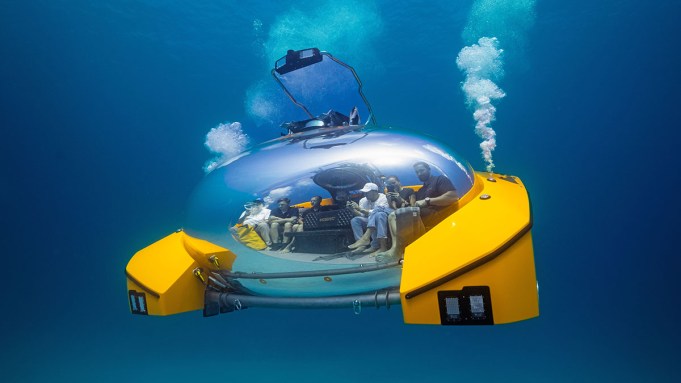Climbing down through the hatch, Chip Barker took his seat in the Scenic Neptune II submersible. He was onboard Scenic Eclipse II cruising in the South Pacific when he had the opportunity to dive in the ship’s new submersible. Barker was apprehensive at first, but he was blown away by the experience, where he saw tropical fish like parrotfish and grouper, eels, coral formations, and an array of blue hues with purples, oranges, and yellows.
“I thoroughly enjoyed it—I didn’t want it to end,” Barker says. “And when it was over, I said I would absolutely do it again.”
For Barker, the best part was getting to experience the advanced technology. “It was almost like getting to go on a space ship,” he says.
Diving in Greenland offers otherworldly views of a rarely seen world.
Courtesy of Seabourn
While luxury expedition cruises can’t take guests into space—yet—they can explore the Earth’s last frontier: the ocean. The Scenic Neptune II submersible Barker explored with is just the latest in a number of different submersible and submarine excursions offered by luxury cruise ship operators, including Scenic, Seabourn, and Viking. These submersibles or submarines (terms the industry often uses interchangeably) can bring small groups of six to eight guests to a maximum of 100 to 300 meters below the ocean’s surface on dives that typically last 30 to 45 minutes. The underwater excursions have proven so popular that Antony Gilbert, Submarine Operations Manager and Chief Pilot at Viking, says some guests will even book twice on the same sailing if there is availability. Voyages start at $499 per person — a drop in the bucket considering a U-Boat Worx Submarine, like the ones Viking has onboard the Viking Octantis and the Viking Polaris, sell for approximately $4.4 million.
“You can literally go on the same dive site twice, three times, four times, and every single time is a different experience,” Gilbert says. “It’s ever-changing.”
Still, the memory of the Titan submersible disaster of June 2023 looms large. Cruise submersible operators are therefore eager to point out the vast differences between the Titan—which was attempting to view wreckage at 12,500 feet down on the ocean floor—and the sightseeing expeditions they offer.
Seabourn’s Vice President General Manager of Expeditions Robin West was onboard one of his company’s ships off of Greenland the day people around the globe learned the Titan had imploded. West says his team took 40 guests down in submersibles that day and no one seemed worried or expressed concerns about safety. The cost of diving with Seabourn ranges from $500 to $1,000 per person.

Seabourn says that tourist recognize that these pleasure dives are far less risky than a journey to the Titanic.
Courtesy of Seabourn
“I think because guests don’t know a lot about submarines they had a lot of questions and they definitely asked some questions,” West says. “But I think many of our guests realize that going to see the Titanic compared to what we’re doing would be like comparing commercial airline flights between Paris and London to trying to get to Mars on a spaceship.”
Each submersible is operated by a trained pilot, and companies inspect and recertify the subs regularly. Onboard, an array of systems and redundancies focus on safety, including things like life support systems that keep people alive for days, to a “dead man’s switch” that automatically raises the submersible, to ROV drones that can hook up cables to tow a sub if need be, or use a cutting tool arm to free it if it were to become entangled.
“Once we really explain all that to guests, at that point there is no fear left and it never stops them,” says Jason Flesher, Director of Discovery Operations for Scenic.
Destinations vary widely based on company and season and can include places like Antarctica, Arctic destinations in Greenland and Canada, the South Pacific, and even the Great Lakes. Some locations may offer the opportunities to view things like shipwrecks, while many view small wildlife under the water. Depending on where they are exploring, guests generally see smaller underwater creatures, like Antarctic krill, corals, sea stars, brittle stars, sea urchins, fish, or even crabs, but occasionally some see larger wildlife, like penguins or even seals.
“We were once at 60 meters depth and a leopard seal followed the sub down” Flesher says of one dive.

Rare sightings on tourist excursions have included giant phantom jellyfish.
Courtesy of Antony Gilbert
Another notable sighting was a giant phantom jellyfish spotted by Viking’s Expedition Team. The finding was published in the scientific journal Polar Research in 2023. In fact, pleasure submersible dives often contribute to scientific research by recording photographs and videos of seldom-traveled underwater areas—and the creatures they observe.
“The nature of expedition is about exploring,” West says. “I think that really is at the heart of what an expedition experience is… We are exploring and educating and showing our guests parts of the world that no single human being has ever seen.”
As undersea exploration provides a way to for guests to visit the underwater world, West compares the underwater voyage to their extraterrestrial counterpart.
“It’s like a spaceship,” West says. “[When] you’re descending and you see the ground slowly coming up, and you see the soft corals and sponges and octopus coming up to you it’s like landing on the moon… I think that’s the only thing that it could be compared to—like landing on a foreign planet.”


